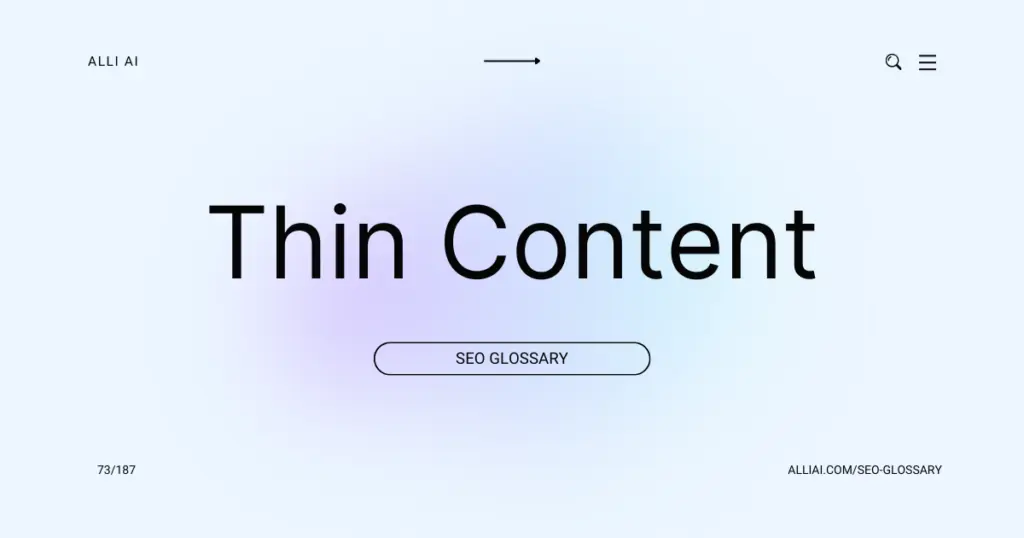What Does Thin Content Mean?
Thin content refers to web pages with little or no valuable content for the user. These pages often lack originality or usefulness, and may include duplicate content, automatically generated content, or pages with only a few lines of text. Thin content provides minimal value to users and can negatively impact a website’s search engine rankings.
Where Does Thin Content Fit Into The Broader SEO Landscape?
Thin content refers to web pages that offer little or no value to users, typically characterized by a lack of or shallow information, low word count, or content that is not relevant to a search query. In SEO, thin content can negatively impact a website’s ranking because search engines, like Google, prioritize high-quality, meaningful, and informative content that fulfills user intent.
Websites with thin content are often penalized by Google’s algorithms, such as Panda, which specifically targets low-quality content. This can lead to lower organic search rankings and decreased traffic. SEO strategies must, therefore, focus on creating and maintaining rich, relevant, and valuable content to improve or sustain rankings and enhance user engagement and satisfaction.
Real Life Analogies or Metaphors to Explain Thin Content
1. Thin content is like a weak handshake: It may perform the basic function but leaves no lasting impression, failing to engage or signify strength in information.
2. Thin content is like fast food: Quick to create and consume, but lacking substantial nutritional value and not satisfying in the long term.
3. Thin content is like a shallow puddle: It covers a broad area lightly but doesn’t have any depth for someone wanting to dive in.
4. Thin content is like a skeleton key: It’s meant to open many doors (ranking for various search queries), but it doesn’t work well enough to unlock any particular door effectively.
5. Thin content is like a ghost town: It exists, but there’s not enough substance or activity to attract and retain visitors.
How the Thin Content Functions or is Implemented?
1. Identification of Thin Content: Search engine algorithms, through web crawlers, identify thin content on webpages. Thin content is typically characterized by a lack of substantial text, low word count, and/or superficial information that doesn’t provide significant value to the reader.
2. Impact on SERPs: Pages identified with thin content are often ranked lower in search engine results pages (SERPs) because they are deemed to not sufficiently answer the user’s search intent or query.
3. Use of Quality Raters: In some cases, human raters following guidelines provided by search engines manually review sites to verify the quality of content, including identifying thin content.
4. Algorithm Updates: Search engines periodically update their algorithms to get better at detecting and penalizing thin content. These updates aim to improve the quality of the content being ranked in SERPs.
5. Penalties: Websites with a lot of thin content may receive penalties, such as reduced search rankings or removal from the index, which decreases their visibility and organic traffic.
6. Content Assessment Metrics: Metrics like bounce rate, time on page, and user interaction are analyzed by algorithms to assess the quality of the content. Poor performance on these metrics can indicate thin content.
7. Searcher Feedback: Search engine algorithms consider user feedback mechanisms like Chrome blocking data or manual spam reports which can help identify low-value content pages.
8. Re-evaluation: Pages previously marked as having thin content can be re-evaluated by search engines after content updates and improvements, potentially restoring their rankings if significant enhancements are made.
Impact Thin Content has on SEO
Thin content negatively impacts a website’s SEO performance and rankings because it typically provides little value to users and fails to satisfy searcher intent. Search engines like Google prioritize content that offers depth, relevance, and value, and their algorithms, especially Google’s Panda, penalize websites with substantial amounts of low-quality, unoriginal, or shallow pages. This results in lower search rankings.
From a user experience perspective, thin content can lead to high bounce rates and low engagement as users may leave the site quickly if they do not find the information useful or comprehensive. This behavior signals to search engines that the content is not fulfilling user needs, which can further diminish search rankings.
SEO Best Practices For Thin Content
1. Identify thin content pages using tools like Google Analytics or Screaming Frog to analyze pages with low word counts, low engagement metrics (high bounce rates, low time on page), or low traffic.
2. Assess each piece of content for relevance, accuracy, and completeness. Determine whether the content answers common user queries and matches search intent.
3. Revamp the content by adding more detailed and informative text. Include statistics, case studies, infographics, and images where relevant to provide greater depth and value.
4. Integrate high-value keywords naturally throughout the content. Use keyword research tools to find related keywords that can also be included to improve SEO.
5. Improve internal linking by adding links to and from the page. Ensure the links are relevant and use descriptive anchor text.
6. Update titles and meta descriptions to be more descriptive and keyword-rich, ensuring they accurately reflect the updated content.
7. Enhance user engagement by improving the layout and formatting of the page, making it easy to read with clear headings, subheadings, and bullet points.
8. Add user-generated content where relevant, such as customer reviews or FAQ sections, to enrich the page’s content and value.
9. Regularly update the content to keep it current and relevant by adding the latest research, data, or industry trends related to the topic.
10. Monitor the page’s performance after updates, using analytics to track changes in engagement, search rankings, and traffic, and making further adjustments as necessary.
Common Mistakes To Avoid
1. Lack of Information Value: Content that is too brief, lacks depth, or doesn’t adequately cover the topics promised in the title can be considered thin. Avoid this by ensuring all content provides valuable, actionable, and comprehensive information relevant to the user’s search query.
2. Auto-generated Content: Relying on software to generate content can lead to nonsensical or irrelevant information. Instead, use human writers who understand the subject matter and can engage users with authentic and useful content.
3. Duplicate Content: Republishing content from other sites or using the same content across multiple pages within your own site can be seen as thin by search engines. Create unique content for each page and if content must be reused, use canonical tags to indicate the preferred URL to search engines.
4. Keyword Stuffing: Overloading content with keywords can make it difficult to read and provide little value to the user. Focus on creating natural, reader-friendly content that uses keywords judiciously and contextually.
5. Low Word Count: While there’s no minimum word count for SEO, very short pages often provide little value. Aim for depth and provide thorough coverage of the topic, which often naturally results in longer content.
6. Poor User Experience: Content that is hidden in pop-ups, surrounded by ads, or split across multiple unnecessary pages (i.e., clickbait) can lead to a poor user experience and be considered thin. Focus on a clean, user-friendly design that makes content easily accessible and enjoyable to consume.
7. Irrelevant Content: Content that is off-topic or irrelevant to the main theme of the site can dilute the overall value of the website. Keep all content on-topic and aligned with the user’s interests and the website’s objectives.
8. Lack of Engagement: Pages that don’t encourage further interaction with the website can be seen as lacking authority or value. Include clear calls-to-action, related content suggestions, and interactive elements to engage visitors.
Avoiding these pitfalls involves strategic planning, quality control, and continuous content evaluation and improvement to ensure it meets the needs of users and adheres to SEO best practices.






